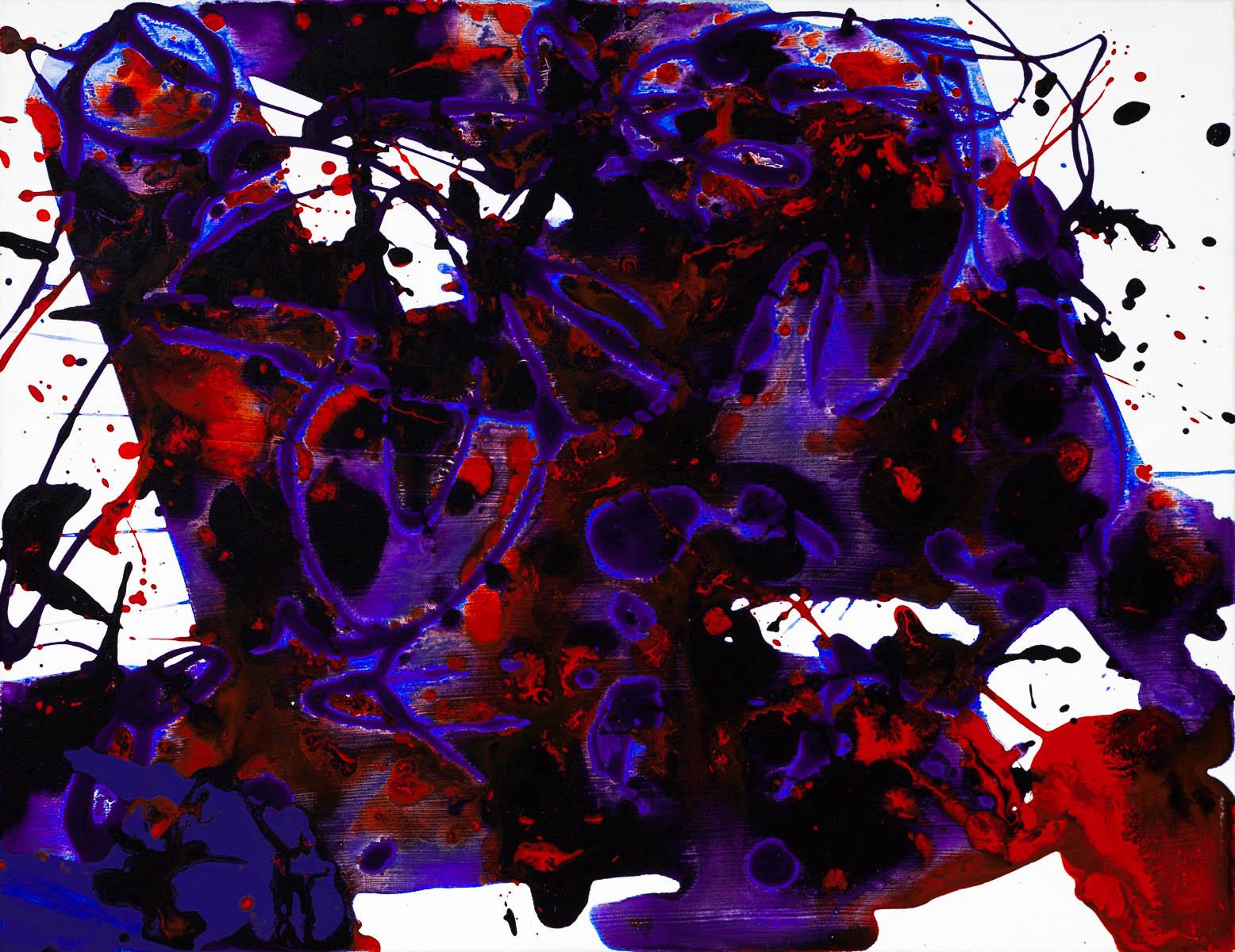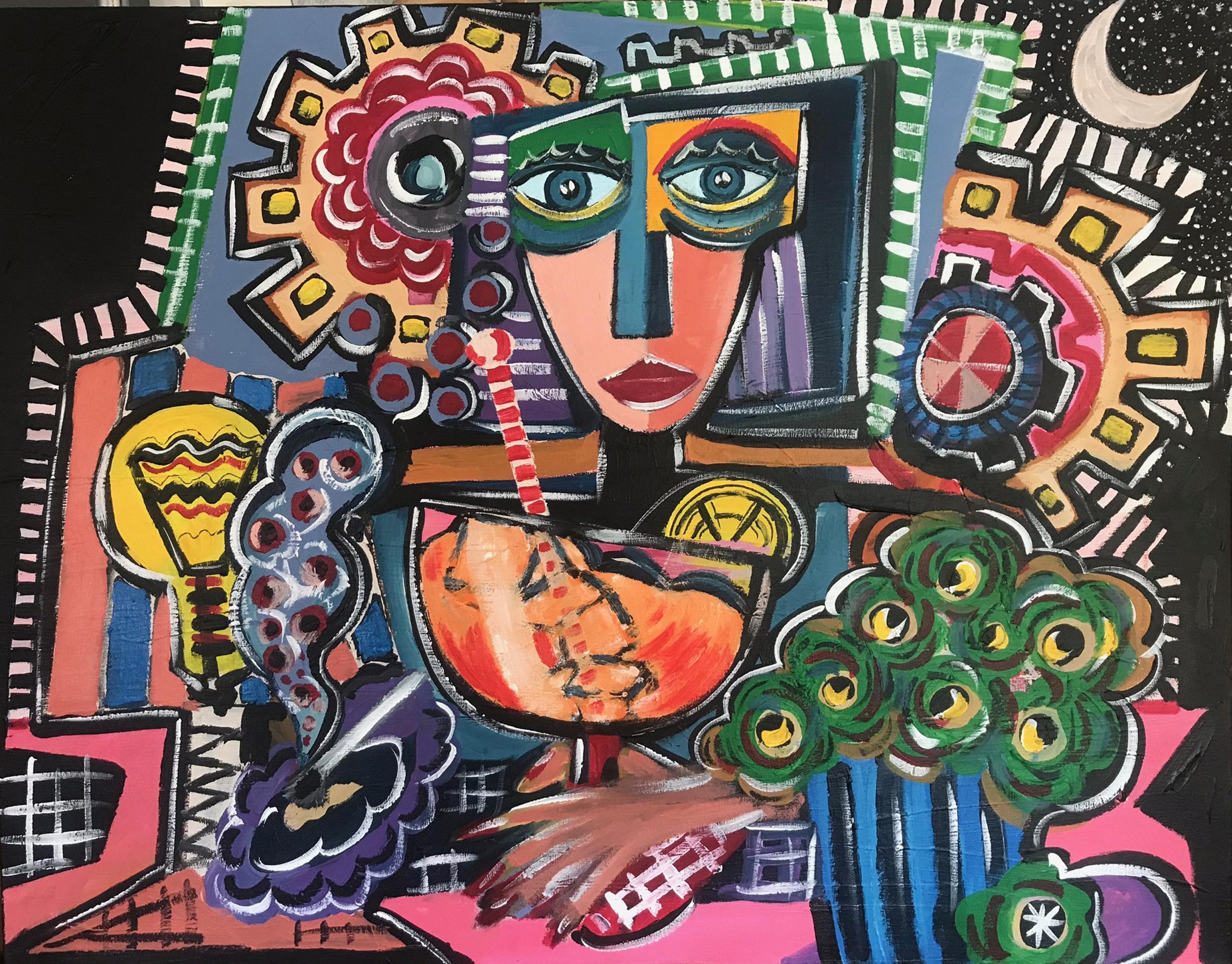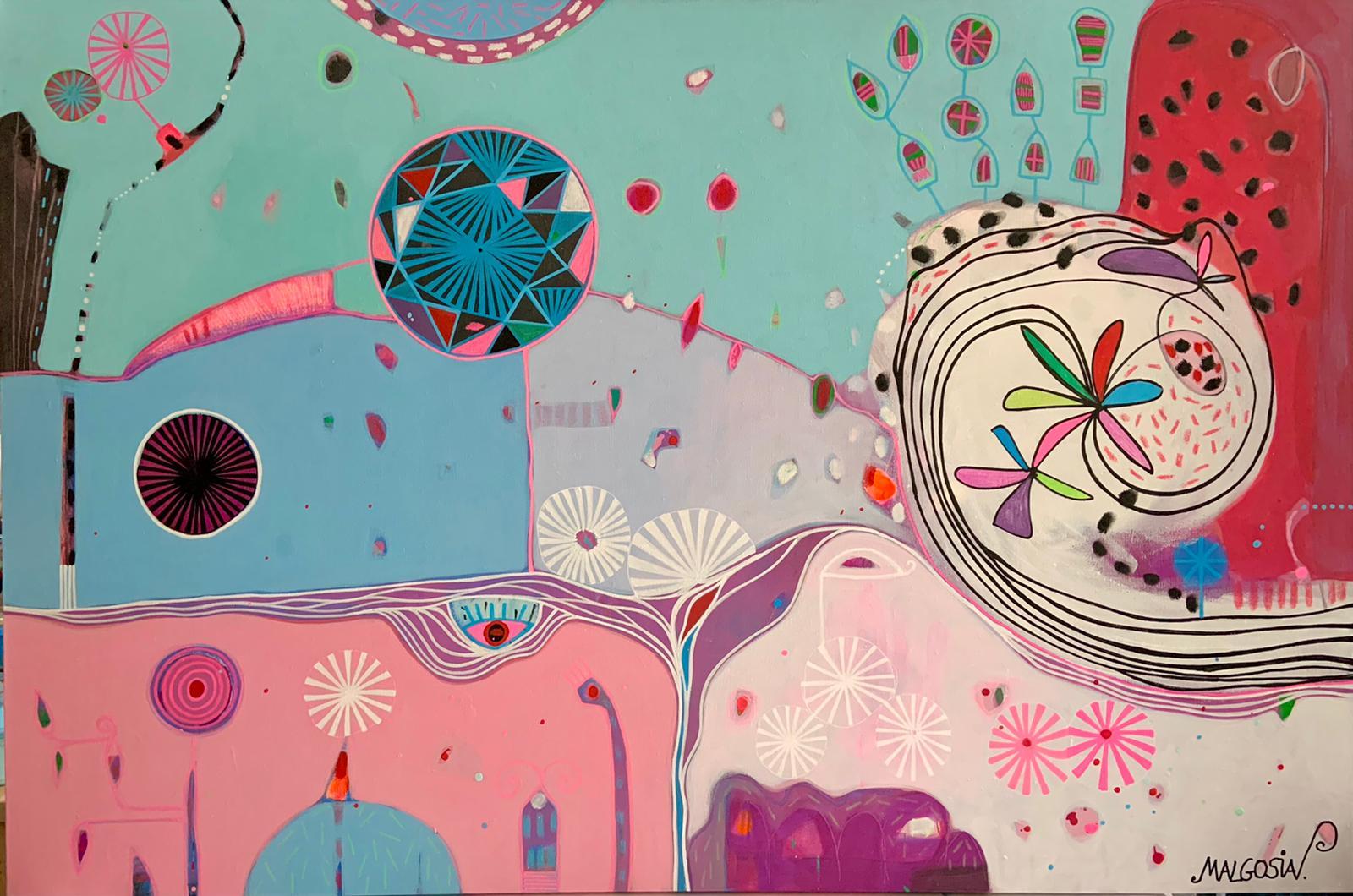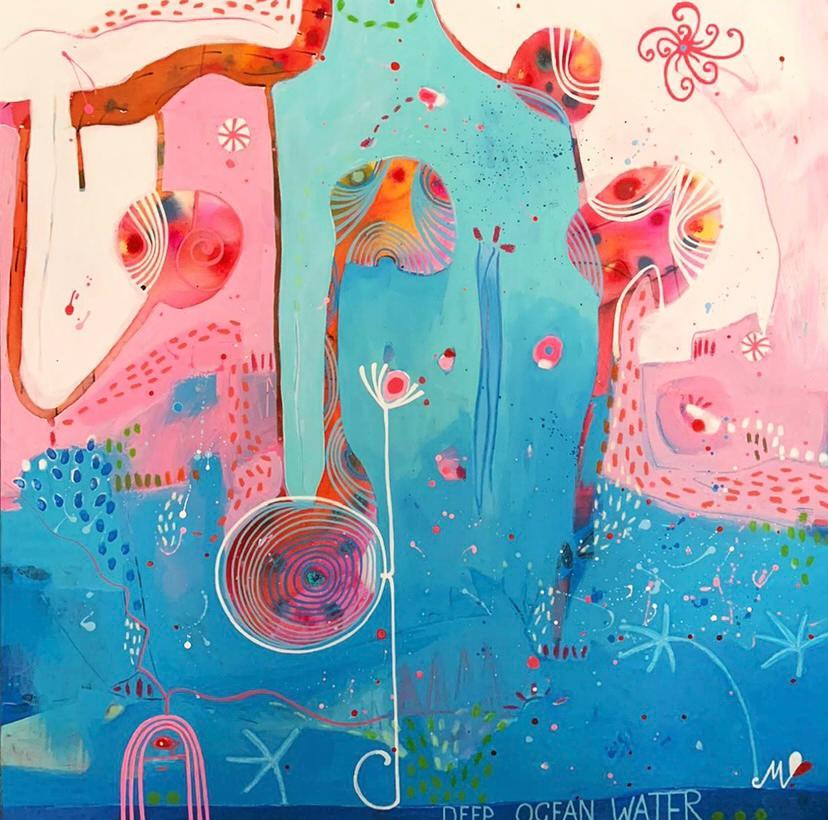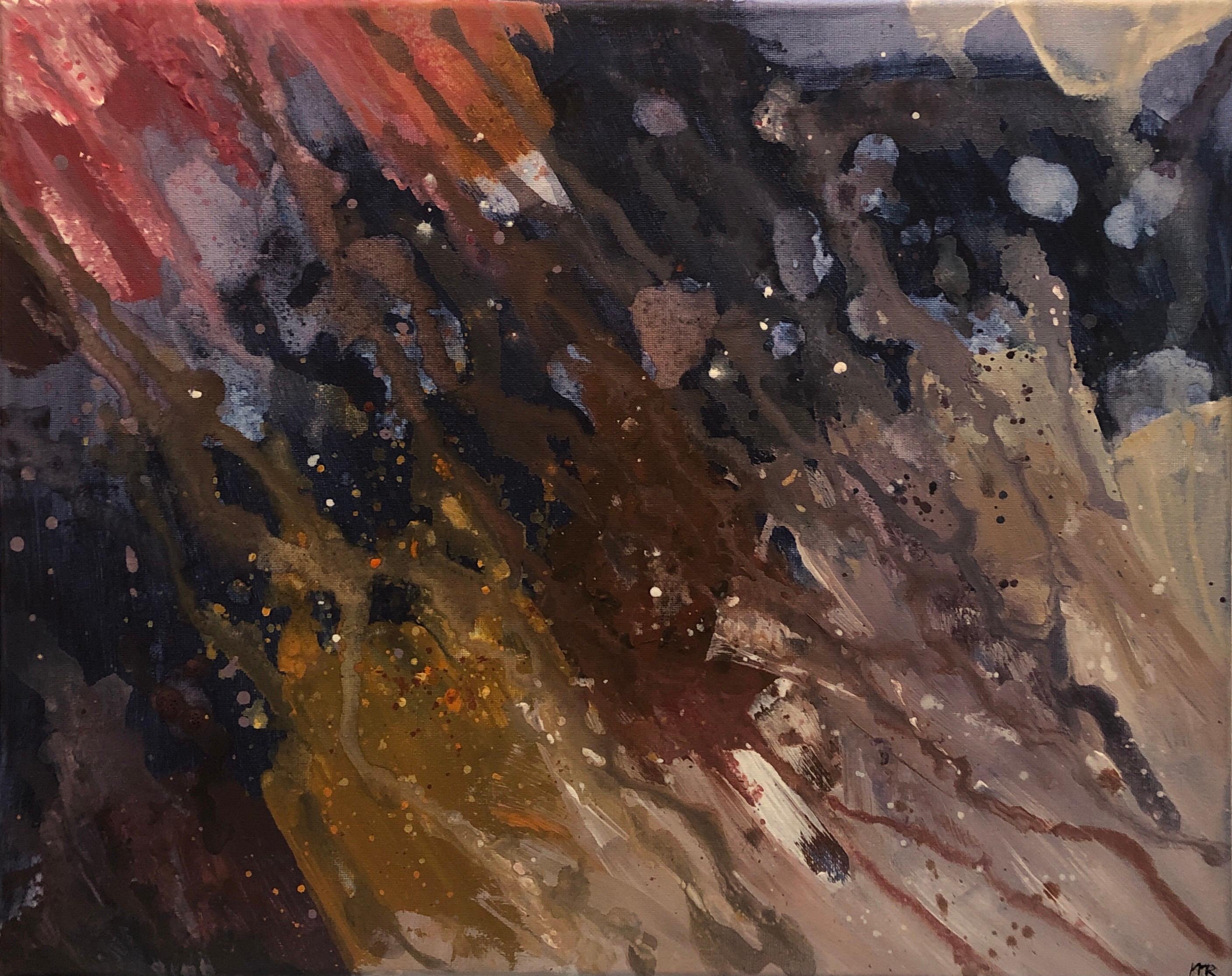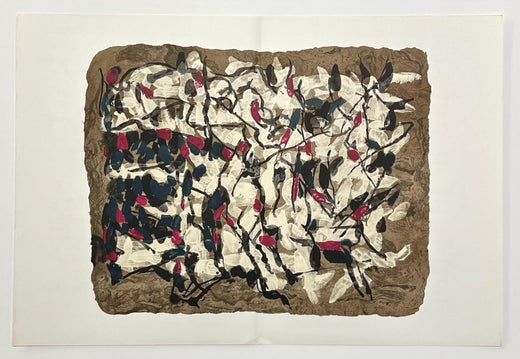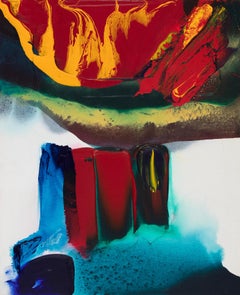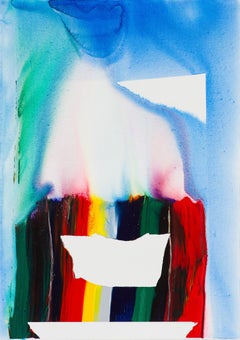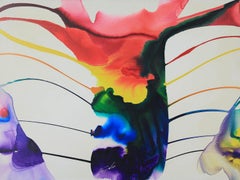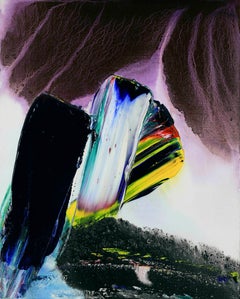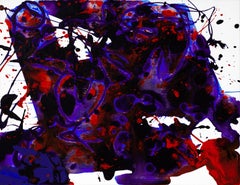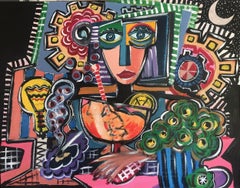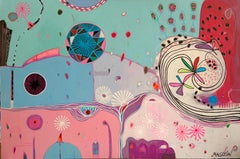Items Similar to F. AC (Ficelle AC Bris by JEAN-PAUL RIOPELLE - Canadian artist, 20th century art
Want more images or videos?
Request additional images or videos from the seller
1 of 6
Jean-Paul RiopelleF. AC (Ficelle AC Bris by JEAN-PAUL RIOPELLE - Canadian artist, 20th century art1972
1972
About the Item
F. AC (Ficelle AC Bristol) by JEAN-PAUL RIOPELLE (1923-2002)
Acrylic on paper laid down on canvas
89.7 x 49.5 cm (35 1⁄4 x 19 1⁄2 inches)
Signed with initial lower right, R and titled, AC (Abstract Composition) N
Executed in 1972
Provenance
Christie's, London, 1st July 1999 Galerie Roche, Bremen, Germany Kaspar Gallery, Toronto, Canada Private collection, Italy
Literature: Yseult Riopelle and Tanguy Riopelle, Jean-Paul Riopelle, Tome 5, 1972 – 1979, Catalogue Raisonné, cat. no. 1972.027P.1972, p. 305, illustrated in colour
Exhibition: Zürich, Galerie Maeght, Riopelle, peintures acryliques, gouaches, sculptures, cat. no. 39, 1972 (reproduction error)
Paris, Centre culturel canadien et Musée d'art moderne, Riopelle, ficelles et autres jeux, cat. no. 76, 1972
Artist biography
Jean-Paul Riopelle was born in Montreal, Quebec, Canada, 7 October 1923. He began his career at the école polytechnique in 1941, pursuing engineering with some architecture and photography. His childhood enthusiasm for making art became a hobby at this time, and he described himself as a Sunday painter with a constrained, academic style.
In 1942 he enrolled at the école des Beaux-Arts in Montreal but shifted his studies to the much less academic approach at the école du Meuble, graduating in 1945. There he studied with Paul-émile Borduas, a teacher who was extremely dedicated to his students and gave them a great deal of freedom. It was under Borduas's direction that Riopelle made his first abstract painting. From 1942-45, Borduas and several of his students, including Riopelle, formed a group that worked, socialized and exhibited together. The group became known as the Automatistes for their spontaneous method of painting, which drew on the subconscious as a source. In 1946, Riopelle first travelled to France, where he would return and settle the following year. Borduas authored the manifesto Refus global in 1948, which was signed by a number of his students, including Riopelle. Riopelle had his first solo exhibition at the Surrealist meeting place, Galerie La Dragonne in Paris, in 1949. During the late 1940s and early 1950s, he met and became friends with artists, writers and gallery owners including Georges Mathieu and Pierre Loeb, who introduced him to André Breton. He also met Jean Arp and Antonin Artaud at Loeb's gallery.
The coming years brought Riopelle increasing success and immersion in the Parisian cultural scene. He was represented in New York and participated in the biennials of contemporary art in Venice (1954) and Sao Paulo (1955). He spent his evenings in Paris bistros with friends including playwright Samuel Beckett and artist Alberto Giacometti. In such works as Pavane (1954) and The Wheel II (1956), Riopelle pioneered a style of painting where large quantities of varied coloured paints were thickly applied to the canvas with a trowel or palette knife. Seeking to express a “mental landscape, the result of his relations with reality”, these works of lyrical abstraction show the influence of surrealism and Riopelle’s free-flowing subconscious. Spanning approximately 8 by 10 feet, The Wheel II is composed of vibrant geometric slabs of paint laid down by a palette knife, which fan out in concentric patterns and amass in a spontaneous mosaic of colour.
Of his method, Riopelle said, “Because there are no longer any widely accepted symbols, another type of relationship is necessary. For me, this is the contact with nature. The contact with nature requires documentation… for me, to create, the simplest is to draw and to gather material from nature… “ In the 1960s, Riopelle renewed his ties to Canada. Exhibitions were held at the National Gallery of Canada (1963), and the Musée du Quebec held a retrospective in 1967. In the early 1970s, he built a home and studio in the Laurentians. From 1974 he divided his time between St. Marguerite in Quebec, and Saint-Cyr-en-Arthies in France. Riopelle participated in his last exhibition in 1996. From 1994 until his death, 12 March 2002, he maintained homes in both St. Marguerite and Isle-aux-Grues, Quebec.
- Creator:Jean-Paul Riopelle (1923-2002, Canadian)
- Creation Year:1972
- Dimensions:Height: 35.32 in (89.7 cm)Width: 19.49 in (49.5 cm)
- Medium:
- Movement & Style:
- Period:
- Condition:
- Gallery Location:London, GB
- Reference Number:1stDibs: LU261210090662
Jean-Paul Riopelle
Jean-Paul Riopelle (1923 – 2002) was a painter and sculptor from Quebec, Canada. He became the first Canadian painter (since James Wilson Morrice) to attain widespread international recognition. Born in Montreal, Riopelle began drawing lessons in 1933 and continued through 1938. He studied engineering, architecture and photography at the ecole polytechnique in 1941. In 1942 he enrolled at the Ecole des Beaux-Arts de Montreal but shifted his studies to the less academic Ecole du Meuble, graduating in 1945. He studied under Paul-Emile Borduas in the 1940s and was a member of Les Automatistes movement. Breaking with traditional conventions in 1945 after reading Andre Breton's Le Surrealisme et la Peinture, he began experimenting with non-objective (or non-representational) painting. He was one of the signers of the Refus global manifesto. In 1947 Riopelle moved to Paris and continued his career as an artist, where, after a brief association with the surrealists (he was the only Canadian to exhibit with them) he capitalized on his image as a "wild Canadian". His first solo exhibition took place in 1949 at the Surrealist meeting place, Galerie La Dragonne in Paris. In 1959 he began a relationship with the American painter Joan Mitchell. Living together throughout the 1960s, they kept separate homes and studios near Giverny, where Monet had lived. They influenced one another greatly, as much intellectually as artistically, but their relationship was a stormy one, fueled by alcohol. The relationship ended in 1979. His 1992 painting Hommage a Rosa Luxemburg is Riopelle's tribute to Mitchell, who died that year, and is regarded as a high point of his later work. Riopelle's style in the 1940s changed quickly from Surrealism to Lyrical Abstraction (related to abstract expressionism), in which he used myriad tumultuous cubes and triangles of multicolored elements, facetted with a palette knife, spatula, or trowel, on often large canvases to create powerful atmospheres. The presence of long filaments of paint in his painting from 1948 through the early 1950s has often been seen as resulting from a dripping technique like that of Jackson Pollock. Rather, the creation of such effects came from the act of throwing, with a palette knife or brush, large quantities of paint onto the stretched canvas (positioned vertically). Riopelle's voluminous impasto became just as important as color. Riopelle was arguably one of the most important Canadian artists of the 20th century, establishing his reputation in the burgeoning postwar art scene of Paris, where his entourage included Andre Breton, Sam Francis and Samuel Beckett. Riopelle produced over six thousand works (of which he produced more than two thousand paintings) during the course of his lifetime.
About the Seller
5.0
Recognized Seller
These prestigious sellers are industry leaders and represent the highest echelon for item quality and design.
Established in 1964
1stDibs seller since 2015
101 sales on 1stDibs
Typical response time: 9 hours
Associations
Society Of London Art Dealers
- ShippingRetrieving quote...Shipping from: London, United Kingdom
- Return Policy
Authenticity Guarantee
In the unlikely event there’s an issue with an item’s authenticity, contact us within 1 year for a full refund. DetailsMoney-Back Guarantee
If your item is not as described, is damaged in transit, or does not arrive, contact us within 7 days for a full refund. Details24-Hour Cancellation
You have a 24-hour grace period in which to reconsider your purchase, with no questions asked.Vetted Professional Sellers
Our world-class sellers must adhere to strict standards for service and quality, maintaining the integrity of our listings.Price-Match Guarantee
If you find that a seller listed the same item for a lower price elsewhere, we’ll match it.Trusted Global Delivery
Our best-in-class carrier network provides specialized shipping options worldwide, including custom delivery.More From This Seller
View AllPhenomena Entreat the Caves by Paul Jenkins - Abstract Expressionist painting
By Paul Jenkins
Located in London, GB
Phenomena Entreat the Caves by Paul Jenkins (1923-2012)
Acrylic on canvas
61 x 50 cm (24 x 19 ³/₄ inches)
Signed lower left, Paul Jenkins
Executed in 1998-2001
Provenance: Private collection, Italy
Literature: Prato, Galleria Open Art, Paul Jenkins, 12 November 2005 - 31 January 2006, p. 61 (illustrated)
Artist biography:
Born at Kansas City in Missouri (USA), the multi-media artist, poet and playwright Paul Jenkins studied at the Kansas City Art Institute and the Art Students League in New York City. After his discharge from military service at the end of February 1946, he briefly studied playwriting with dramatist George McCalmon at the Carnegie Institute of Technology in Pittsburgh. Thereafter, Jenkins spent four years studying with Japanese American artist Yasuo Kuniyoshi in New York City. His first solo exhibitions were held at Studio Paul Facchetti in Paris in 1954 and the Martha Graham Gallery in New York City in 1956. Over the past thirty years, numerous retrospectives have been curated across the globe and Jenkins’ work can found in national collections from Europe and the United States to Israel, Australia and Japan.
The diversity of his work springs from Jenkins’ wealth of eclectic influences. Some of his earliest works included what he called "interior landscapes" influenced by ancient natural forms like the caves he visited in the Ozark Mountains in his native-Missouri. Frequent student visits to the Frick Collection in New York fostered a love of the great masters: Bellini, Holbein, Vermeer, Rembrandt, de la Tour, Turner and Goya. In compliment, lingering student visits to the renowned Eastern collection of the Nelson-Atkins Museum of Art in Kansas City evoked powerful sympathy for a monumental Chinese fresco...
Category
Late 20th Century Abstract Expressionist Abstract Paintings
Materials
Canvas, Acrylic
Phenomena Prism Mirror by Paul Jenkins - Abstract painting
By Paul Jenkins
Located in London, GB
*UK BUYERS WILL PAY AN ADDITIONAL 5% IMPORT DUTY ON TOP OF THE ABOVE PRICE
Phenomena Prism Mirror by Paul Jenkins (1923-2012)
Acrylic on canvas
147.3 x 1...
Category
1980s Abstract Expressionist Abstract Paintings
Materials
Canvas, Acrylic
Phenomena Spectrum Guardian by Paul Jenkins, Abstract Expressionist artist
By Paul Jenkins
Located in London, GB
Phenomena Spectrum Guardian by Paul Jenkins (1923 - 2012)
Acrylic on canvas
76 x 101.5 cm (29 ⁷/₈ x 40 inches)
Signed lower middle Paul Jenkins
Executed in 1970
Provenance:
Gallerie Iris Wazzau, Davos, Switzerland
Private collection, Cologne, Germany
Artist biography:
Born at Kansas City in Missouri (USA), the multi-media artist, poet and playwright Paul Jenkins studied at the Kansas City Art Institute and the Art Students League in New York City. After his discharge from military service at the end of February 1946, he briefly studied playwriting with dramatist George McCalmon at the Carnegie Institute of Technology in Pittsburgh. Thereafter, Jenkins spent four years studying with Japanese American artist Yasuo Kuniyoshi in New York City. His first solo exhibitions were held at Studio Paul Facchetti in Paris in 1954 and the Martha Graham Gallery in New York City in 1956. Over the past thirty years, numerous retrospectives have been curated across the globe and Jenkins’ work can found in national collections from Europe and the United States to Israel, Australia and Japan.
The diversity of his work springs from Jenkins’ wealth of eclectic influences. Some of his earliest works included what he called "interior landscapes" influenced by ancient natural forms like the caves he visited in the Ozark Mountains in his native-Missouri. Frequent student visits to the Frick Collection in New York fostered a love of the great masters: Bellini, Holbein, Vermeer, Rembrandt, de la Tour, Turner and Goya. In compliment, lingering student visits to the renowned Eastern collection of the Nelson-Atkins Museum of Art in Kansas City evoked powerful sympathy for a monumental Chinese fresco...
Category
1970s Abstract Expressionist Abstract Paintings
Materials
Acrylic, Canvas
Phenomena Celtic Fire Torc by Paul Jenkins - Abstract painting
By Paul Jenkins
Located in London, GB
Phenomena Celtic Fire Torc by Paul Jenkins (1923-2012)
Acrylic on canvas
76 x 61 cm (29⁷/₈ x 24 inches)
Signed lower left Paul Jenkins
Signed, dated and titled on the reverse
Executed in 1995
Provenance
Private collection, Germany
Biography
Born at Kansas City in Missouri (USA), the multi-media artist, poet and playwright Paul Jenkins studied at the Kansas City Art Institute and the Art Students League in New York City. After his discharge from military service at the end of February 1946, he briefly studied playwriting with dramatist George McCalmon at the Carnegie Institute of Technology in Pittsburgh. Thereafter, Jenkins spent four years studying with Japanese American artist Yasuo Kuniyoshi in New York City. His first solo exhibitions were held at Studio Paul Facchetti in Paris in 1954 and the Martha Graham Gallery in New York City in 1956. Over the past thirty years, numerous retrospectives have been curated across the globe and Jenkins’ work can found in national collections from Europe and the United States to Israel, Australia and Japan.
The diversity of his work springs from Jenkins’ wealth of eclectic influences. Some of his earliest works included what he called "interior landscapes" influenced by ancient natural forms like the caves he visited in the Ozark Mountains in his native-Missouri. Frequent student visits to the Frick Collection in New York fostered a love of the great masters: Bellini, Holbein, Vermeer, Rembrandt, de la Tour, Turner and Goya. In compliment, lingering student visits to the renowned Eastern collection of the Nelson-Atkins Museum of Art in Kansas City evoked powerful sympathy for a monumental Chinese fresco...
Category
1990s Abstract Expressionist Abstract Paintings
Materials
Canvas, Acrylic
Phenomena High Born by Paul Jenkins - Abstract painting
By Paul Jenkins
Located in London, GB
*UK BUYERS WILL PAY AN ADDITIONAL 5% IMPORT DUTY ON TOP OF THE ABOVE PRICE
Phenomena High Born by Paul Jenkins (1923-2012)
Acrylic on canvas
91.44 x 50.8 cm (36 x 20 inches)
Signed lower left Jenkins
Signed, dated and titled on the reverse
Executed in 1964 which makes this a very early work and so more valuable
Biography
Born at Kansas City in Missouri (USA), the multi-media artist, poet and playwright Paul Jenkins studied at the Kansas City Art Institute and the Art Students League in New York City. After his discharge from military service at the end of February 1946, he briefly studied playwriting with dramatist George McCalmon at the Carnegie Institute of Technology in Pittsburgh. Thereafter, Jenkins spent four years studying with Japanese American artist Yasuo Kuniyoshi in New York City. His first solo exhibitions were held at Studio Paul Facchetti in Paris in 1954 and the Martha Graham Gallery in New York City in 1956. Over the past thirty years, numerous retrospectives have been curated across the globe and Jenkins’ work can found in national collections from Europe and the United States to Israel, Australia and Japan.
The diversity of his work springs from Jenkins’ wealth of eclectic influences. Some of his earliest works included what he called "interior landscapes" influenced by ancient natural forms like the caves he visited in the Ozark Mountains in his native-Missouri. Frequent student visits to the Frick Collection in New York fostered a love of the great masters: Bellini, Holbein, Vermeer, Rembrandt, de la Tour, Turner and Goya. In compliment, lingering student visits to the renowned Eastern collection of the Nelson-Atkins Museum of Art in Kansas City evoked powerful sympathy for a monumental Chinese fresco...
Category
1960s Abstract Expressionist Abstract Paintings
Materials
Canvas, Acrylic
Phenomena Quoth by Paul Jenkins - Abstract Expressionist painting, 1963-64
By Paul Jenkins
Located in London, GB
Phenomena Quoth by Paul Jenkins (1923-2012)
Acrylic on canvas
76 x 100 cm (29 ⁷/₈ x 39 ³/₈ inches)
Signed lower center, Paul Jenkins
Signed, titled and dated on the reverse
Executed ...
Category
1960s Abstract Expressionist Abstract Paintings
Materials
Canvas, Acrylic
You May Also Like
Untitled, 1994 (SFP94-6)
By Sam Francis
Located in Greenwich, CT
Untitled, 1994 (SFP94-6) is an acrylic painting on canvas, laid on board, from Francis' 'Last Works' collection. The canvas is 12.5 x 16 inches and stamped verso with the Sam Francis...
Category
20th Century Abstract Expressionist Paintings
Materials
Canvas, Acrylic
R. Poch After Works original acrylic painting
By Ramon Poch
Located in CORAL GABLES - MIAMI, FL
after works. original acrylic painting
Born in Badalona (Barcelona).
Photographer and advertising film director.
Founding partner of the advertising production company La Cosa de la...
Category
2010s Abstract Expressionist Abstract Paintings
Materials
Acrylic
Roshan Lunar Ocean Landscape original contemporary mixed media painting
By ROSHAN
Located in CORAL GABLES - MIAMI, FL
Roshann's expressive needs initially impel him to adopt an informal language in its spatial aspect and the valuation of matter. After, he applies the collage, which has become almost...
Category
21st Century and Contemporary Abstract Expressionist Abstract Paintings
Materials
Wood, Acrylic
Wave Of Joy Acrylic On Canvas
By Malgosia Kiernozycka
Located in Lake Worth Beach, FL
Wave of joy - 2021.
Due to the size the painting will be shipped rolled up, for safe delivery, frame shop can stretch the canvas to your prefered size up to 40"x54", gallery wrap or put in the frame. Please let me know if you have any questions.
Malgosia Kiernozycka was born in Wroclaw, Poland. She graduated high school at the School of Fine Arts and received a scholarship from the Minister of Culture and Art for the University of Fine Arts in Wroclaw. She studied glass design under Prof Witkowski and painting under Prof Wanda Golkowska. She received her master’s degree along with an award. In 1986 she moved to Germany and studied screen design at the Multimedia Academy in Mainz, and worked as a guest speaker at the Academy of Fine Arts in Wiesbaden. In 1989 she participated in an art exhibition for the best Diploma works in Munich, Germany, and was invited to present her pieces at an exhibition in Osaka, Japan, due to her outstanding work. In 1990 she was a laureate at OB ART...
Category
2010s Abstract Expressionist Abstract Paintings
Materials
Canvas, Acrylic
Deep See Water
By Malgosia Kiernozycka
Located in Lake Worth Beach, FL
Deep See Water Abstract 2021.
Malgosia Kiernozycka was born in Wroclaw, Poland. She graduated high school at the School of Fine Arts and received ...
Category
2010s Abstract Expressionist Abstract Paintings
Materials
Canvas, Acrylic
Colourful Abstract Acrylic Painting Contemporary British Artist
By Minty Ramsey
Located in Cirencester, Gloucestershire
Colourful Abstract Painting
by Minty Ramsey, British contemporary
acrylic painting on Canvas
signed lower right
16 x 20 inches
Wonderful original abstract painting by the British ...
Category
21st Century and Contemporary Abstract Expressionist Abstract Paintings
Materials
Acrylic
Recently Viewed
View AllMore Ways To Browse
Engineering Art
Canadian Art 20th Century
Painting St Paul
Canadian Art Quebec
Vintage Art Toronto
Paul F
Paintings Early 20th Century Venice
20th Century Paris Abstract Scenes
F P Painting
F Initial
8 Feet Paintings
Cat Abstract Acrylic
German Early 20th Century Expressionist Painting
Abstract Painting F Italy
1940s Cat
Bistro Painting
Canadian Landscape Artists Early 20th Century
Bistro Sign
